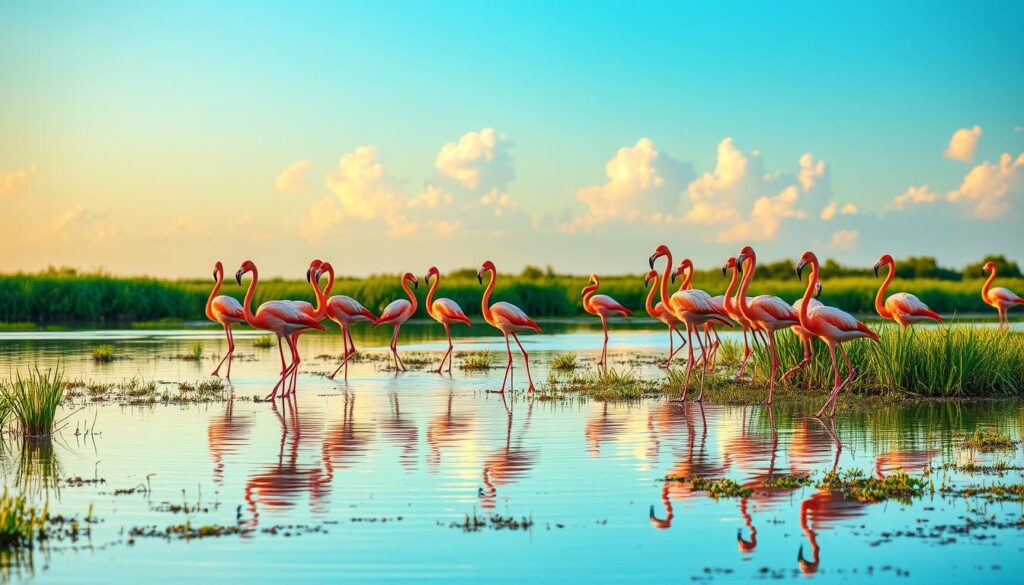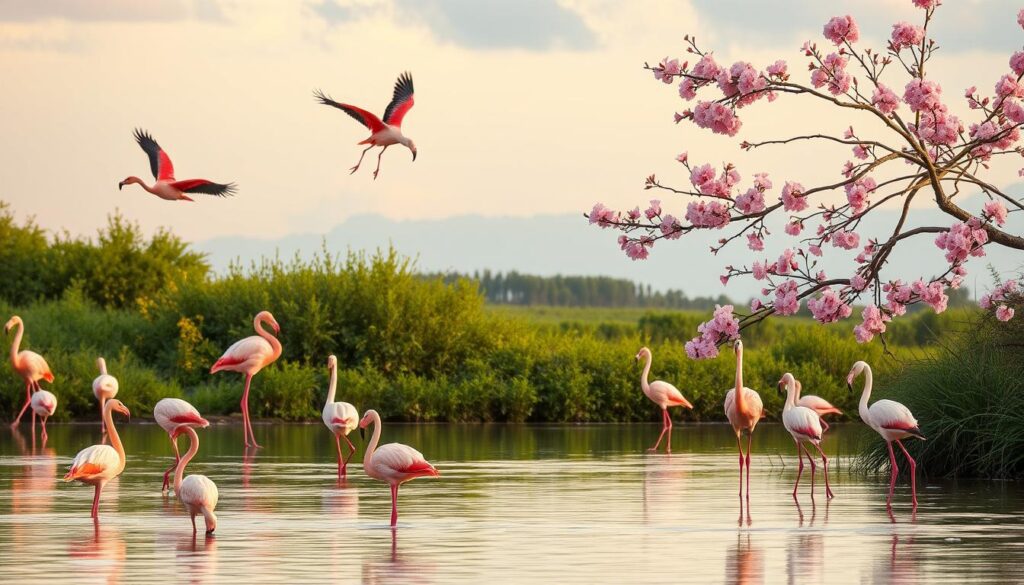5 Pink Birds: Discover Nature’s Rosy-Colored Beauties
Table of Contents
Step into the world of ornithology and get ready to be amazed by pink birds. These birds are a true delight, with their vibrant colors showing Mother Nature’s creativity. From flamingos to lesser-known species, their beauty is undeniable.
“We’ll explore the world of these colorful creatures, learning about their history, cultural importance, and how they get their distinctive hues. Whether you love birdwatching or simply enjoy the beauty of nature, this journey will amaze you.”
Understanding the World of These Colorful Creatures: From Legends to Reality
Exploring the world of pink birds reveals nature’s vibrant colors. These birds have stunning plumage and hold cultural significance. They capture our imagination and tell fascinating stories.
The Science Behind Pink Plumage
Some birds get their rosy color from their diet, genetics, and environment. Species like rosy finches derive their pink hue from carotenoids found in their food. These pigments tint their feathers, capturing everyone’s attention.
Natural Habitats and Distribution
“These birds can be found in many regions around the world — from the wetlands of South America to the deserts of Africa. For instance, pink pigeons inhabit the forests of Mauritius, while similar species in Australia prefer coastal environments. Understanding their habitats highlights their adaptability.”
Cultural Significance Across Civilizations
These colorful birds have long fascinated cultures. In ancient Egypt, they were admired for their striking appearance. In China, rosy finches were seen as symbols of good luck. Their presence in myths and art highlights their cultural significance.
“With their delicate and vibrant plumage, these stunning creatures are a true wonder of nature, inviting us to pause and appreciate the beauty that surrounds us.”
Iconic Species: Flamingos and Roseate Spoonbills
Flamingos and roseate spoonbills are among the most stunning birds. They captivate birdwatchers and nature lovers with their vivid colors and unique characteristics.
Flamingos have long necks and bent beaks. They live in salty lakes and eat shrimp and algae. This diet makes their feathers bright pink. They live in many places, like the Americas, Africa, and Europe. But, some face threats from losing their homes and human activities.
Roseate spoonbills live mainly in the Americas. They are known for their spoon-shaped bills. They use these to catch fish and other small creatures. Their feathers can be pale pink to deep rose, getting even brighter when they breed.
| Characteristic | Flamingos | Roseate Spoonbills |
|---|---|---|
| Plumage Color | Bright pink | Pale to deep rose |
| Beak Shape | Long, slender, and bent | Spoon-shaped |
| Habitat | Saline and alkaline lakes | Coastal wetlands and estuaries |
| Diet | Tiny shrimp and algae | Small fish, crustaceans, and aquatic invertebrates |
Flamingos and roseate spoonbills are iconic in their regions. They inspire art, folklore, and environmental protection efforts. These remarkable creatures remind us of the beauty and diversity of our world.

Rare and Lesser-Known Birds Around the Globe
While flamingos and roseate spoonbills often steal the spotlight, many other unique species deserve recognition. Let’s explore the stories of these remarkable birds. Each has its own beauty and faces its own set of challenges.
Pink Robins of Australia
The pink robin is a treasure found in southeastern Australia’s forests. These small birds have beautiful pink feathers and black markings. They are a joy to watch, but their homes are disappearing, putting them at risk.
Galah Cockatoos: Australia’s Rose-Breasted Parrots
The galah cockatoo is a famous pink bird from Australia’s dry lands. Known for their pink and gray feathers, these parrots are full of life. They love cities, but their homes are being taken away, making it hard for them to survive.
The Endangered Pink Pigeon
The pink pigeon is a bird that was once almost gone forever. It lives in the forests of Mauritius and is known for its bright pink color. Thanks to hard work by conservationists, these pigeons are coming back. But they still face dangers from their environment and predators.
| Species | Native Region | Conservation Status |
|---|---|---|
| Pink Robin | Southeastern Australia | Least Concern |
| Galah Cockatoo | Arid regions of Australia | Least Concern |
| Pink Pigeon | Mauritius | Endangered |
These vibrant creatures show us how incredible our world can be. By working to protect them, we can ensure they continue to inspire us for generations to come.

Conservation Status and Protection of These Birds
These beautiful birds are a sight to behold, but many face serious challenges. Roseate terns, for example, are at risk. Their populations are declining due to habitat loss and human activity.
Species like the endangered pink pigeon and the vulnerable galah cockatoo are also under threat. They face dangers such as climate change and predators. However, thanks to conservation efforts, their future is becoming more hopeful. Organizations like BirdLife International and local wildlife teams are working hard to protect them.
You can make a difference too. Support conservation groups, adopt sustainable habits, and advocate for protective legislation. Together, we can ensure these birds remain a part of our world for generations to come.e.

